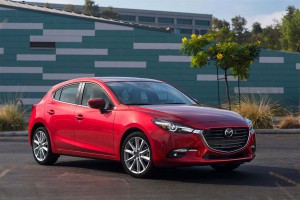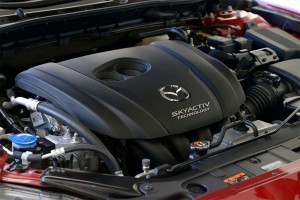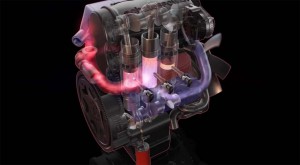Barring a sudden shift by the new Trump Administration, automakers are facing a tough federal fuel economy target for 2025, and that has them looking at a variety of ways to deliver book mileage gains over the next few years.
Along with various battery-based technologies, a number of exotic internal combustion technologies are vying for acceptance, including a concept known as the homogeneous-charge compression ignition, or HCCI, engine. Combining attributes of the diesel but powered by gasoline, and promising major improvements in efficiency, HCCI may finally be ready for prime time.
According to a report by Japan’s Nikkei Asian Review, Mazda and another, unnamed manufacturer plant launch an engine using HCCI technology late in 2018. Set to be used in the little Mazda3, the new SkyActiv engine is expected to deliver as much as a 30% bump in fuel economy compared to a comparable, conventional gas engine.
By one estimate, that would mean as much as 70 miles per gallon using the Japanese fuel-efficiency test, though the number would likely drop somewhere into the 50s using the U.S. Environmental Protection Agency test cycle.
(EPA finalizes 54.5 CAFE rules. Click Here for the latest.)
Homogeneous-charge engines, at their simplest, use extremely high compression rations – Mazda’s version would run at about 18:1 compared to conventional gas engines that are more typical in the 9:1 to 11:1 range. As a result, the air/fuel mixture would self-ignite, rather than requiring a spark plug.
The approach yields the sort of energy efficiency which normally is found in a diesel engine, but HCCI gets there without the troubling emissions problems that plague diesels. They generate extremely low levels of smog-causing oxides of nitrogen, for example, though HCCI exhaust must still be treated to meet the latest emissions standards, especially for unburnt hydrocarbons and carbon monoxide.
Those are advantages that have intrigued a number of automakers, including General Motors, Hyundai and Daimler. But HCCI engines also have a number of drawbacks that have so far restricted the technology from going into mass production.
HCCI engines have trouble operating at low temperatures. And they operate best in fairly narrow RPM and power band ranges. They also tend to be noisy and rough, something they have in common with diesels.
So, it would be a major coup if Mazda has, indeed, figured out a solution to the HCCI challenge. According to the Nikkei, the homogeneous-charge package will be positioned as the second-generation SkyActiv powertrain. And it will make its debut late next year as a 2020 model. While the little Mazda3 will be the first to use the new engine it will soon be integrated into other Mazda models.
About the same time, the Hiroshima-based automaker is expected to launch its first pure battery-electric vehicle, with a plug-in hybrid to follow in 2021.
Several other automakers continue to work on HCCI technology, Nissan reportedly hoping to eventually incorporate the concept into the new Variable-Compression Turbo engine it will launch with the next-generation QX50 crossover next year. The VC-T can operate at compression ratios ranging from 8:1 to 14:1, depending upon demands for power and fuel economy.
(Click Here for details on the QX50 Concept and the VC-T engine.)
More than a half-dozen automakers are reportedly funding research by Achates, a San Diego-based research and engineering firm. Dubbed the opposed-piston engine, or OP-E, it uses two pistons per cylinder and also relies on compression, rather than spark, ignition, to yield as much as 50% better mileage than a conventional gas engine.
Achates has clocked thousands of hours of lab work and hopes to begin street testing over the next year, with production possible in the not-too-distant future.
(Click Here for more on the Achates engine.)
All alternative engines have high hurdles to meet before they can make it into production. Cost is a key factor, especially if they require manufacturers to tear up existing engine lines. Emissions are another speedbump, as are questions about performance, noise, harshness, long-term reliability and customer acceptance.
But with the specter of having to meet the 54.5 mpg Corporate Average Fuel Economy standard going into effect in 2025, automakers are facing some hard choices that could require them to make some difficult compromises.




I want to say this was tried before decades ago by Honda on their Civic, but I believe I may be confusing it with another acronym?
In any event, the literature on the HCCI is interesting.